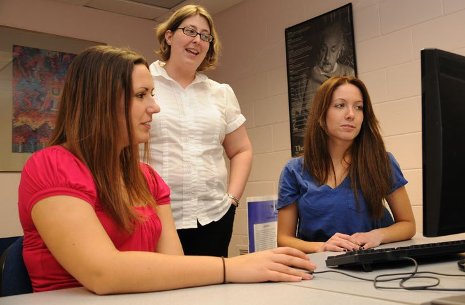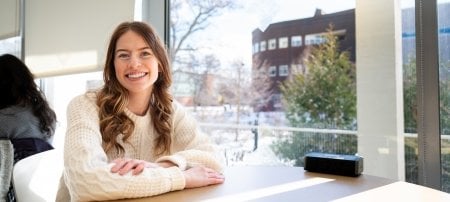Looking at student sleep (and stress and exercise) patterns

How much sleep do Michigan Tech students get? And how do exercise and stress relate to sleep patterns?
Undergraduate students Alison Greene and Abrah Maki are researching just that, under the guidance of Leanne Forquer, visiting assistant psychology professor. Their work is on display April 15 at Undergraduate Expo.
“Seven and one-half hours per weeknight,” Greene says. “And eight and one-half on the weekends.” It takes an average of 23.7 minutes for the students to fall asleep, and they get up an average of one to two times per night, according to the results. Reasons for waking up included “worried/thinking about something,” “to use the bathroom,” and “noise.”
Male Tech male students sleep a bit more than female students, too, according to Forquer.
The students and Forquer compiled the information with an online survey that was completed by 118 students enrolled in general psychology and other classes.
Other studies have looked at sleep and fitness, and others analyzed sleep and stress, but the Tech study differs in that they also looked at academic self-efficacy, which is “one’s belief that they can accomplish novel and difficult tasks and cope with adversity within academics,” according to Forquer.
“We used four different surveys,” Maki says. “Sleep, fitness, stress, and, in the self-efficacy survey, we ask questions about academics.”
In the efficacy section, students responded to statements such as: “I can always manage to solve difficult problems, in an academic setting, if I try hard enough,” and “I can remain calm when facing difficulties in an academic setting because I can rely on my coping abilities.” Their responses varied on a four-point scale from “Not at all true” to “Exactly true.”
After further perusing the data, Forquer found some other interesting results.
“Higher fitness levels were correlated with high academic self-efficacy,” Forquer said, “and those higher self-efficacy scores were correlated with higher GPAs.”
She also said that students who have higher levels of stress report significantly lower academic self-efficacy scores and significantly lower fitness scores.
And, when do they sleep?
The results say that most go to bed around midnight on weeknights and 2 a.m. on the weekends. Average rise-time during the week was 8:05 a.m.; average rise-time on weekends was 9:45 a.m. Thirty-six percent of students reported using some type of sound to help them sleep: most common were fans and music; 6 percent of students reported using some other type of sleep aids, most commonly medications or earplugs; 35 percent of students report napping during the day; most students who do so nap from between 30 and 90 minutes during either the afternoon or evening.
And how does their sleep affect school performance?
Sixty-one percent of students report that not getting enough sleep at night has caused them to have trouble waking up to go to class; 68 percent of students report that not getting enough sleep at night has caused them to have trouble paying attention in class; 41 percent of students admit to falling asleep in class; and 33 percent of students admit that not getting enough sleep at night has caused them to do poorly on a test or assignment.
Looking at the three factors:
Stress: Students’ average stress was 65.5 on a 108-point scale, with higher scores indicating greater amounts of stress.
Self-efficacy: 31.6 on a 40-point scale.
Fitness level: Students average 54.4 on an 80-point score, with higher scores associated with greater fitness levels.
Demographics:
63 percent male, average age 20.6 years, 88 percent white, 39 percent freshmen, 20
percent sophomores, 19 percent juniors, 22 percent seniors, 48 percent live in the
residence hall, 42 percent live off campus. Average GPA is 2.9.
Michigan Technological University is an R1 public research university founded in 1885 in Houghton, and is home to nearly 7,500 students from more than 60 countries around the world. Consistently ranked among the best universities in the country for return on investment, Michigan's flagship technological university offers more than 185 undergraduate and graduate degree programs in science and technology, engineering, computing, forestry, business, health professions, humanities, mathematics, social sciences, and the arts. The rural campus is situated just miles from Lake Superior in Michigan's Upper Peninsula, offering year-round opportunities for outdoor adventure.




Comments